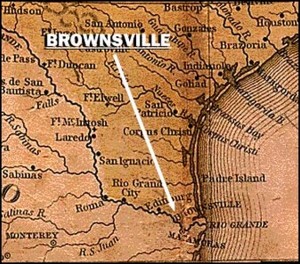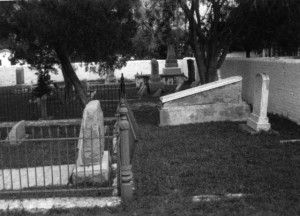Jewish Views of Brownsville, Texas & Matamoros, Mexico
Benjamin B. Kowalski, later Mayor of Brownsville, writing in 1876:
“Brownsville is located on the Rio Grande and has a population of 4,000 souls, a college and several churches. Matamoros, Mexico, directly opposite Brownsville has a population of about 20,000.”
“The firm of Bloomberg & Raphael is of good standing and has all the frontier trade. A. Marks & Bro., of Matamoros has a good deal of the Mexican trade. On both sides of the border, the Jews are respected by all citizens.”
“In our last election [1875 or 76], Mr. G.M. Raphael was re-elected Alderman and is now acting Mayor. Mr. Lewis Cowen was re-elected City Secretary. Mr. Sol Asheim was re-elected County Treasurer. Your humble servant [Kowalski] has been Assistant Postmaster for the past three years.”
“Brownsville has a Jewish population of just ten. Matamoros has about fifteen Jehudim – about five or six families.” [Together they formed a Hebrew Benevolent Society with Benjamin B. Kowalski as its president.] The society “relieved many a poor and destitute Hebrew.”
“Feast and fast days are held in Matamotos where we have a Torah, although the congregation consists of German and Polish Jews and have different minhag [rites] which make for interesting disagreements. Our Jewish cemetery is a block wide and surrounded by a brick wall. The few that are buried there have been murdered in Mexico.”
Rabbi Abraham Blum* of Galveston, writing in 1882:
“My trip to Brownsville and Matamoros will be one of the most pleasant reminiscences of my life. The idea which prevails that there is a rough life on the Mexican borders and that ones life is in danger, is false. The people are peaceful on both sides. Only now and then a man is waylaid when he makes a show of carrying plenty of money.”
“The Israelites of these two cities attend to their own business, take an interest in the welfare of the community wherein they live, contribute liberally to every public and religious institution, and are not ashamed to acknowledge that they are Israelites.”
“The house of Messrs. Bloomberg & Raphael [wholesale merchants in Brownsville] also employs as junior member, Mr. G. M. Raphael, one of the most intelligent Israelites one could meet. Mr. G. M. Raphael offered, at his own expense, to send for a Jewish minister to perform a wedding ceremony for a young Jewish couple rather than see the same done by a justice of the peace.”
“[In Matamorso] Mr. G. Marks is a leading citizen. Mr. Jacques Levy keeps a wholesale tobacco & liquor store.”
“Brownsville and Matamoros together number about fifty Jewish souls. They have a Hebrew Benevolent Society and a beautiful burying ground and an active Sunday School. Its officers are: President: L. Cowen and Superintendent of the Sabbath School; Vice-President: G. Marks; Treasurer: M. Asheim; Secretary: S. B. Benjamin.”
“Mr. L. Cowen is Grand Master of the Masonic Order.”
“Dr. A.S. Wolff, a physician is the Quarantine Officer and the Surgeon at near-by Fort Brown. Mr. Benjamin Kowalski is Brownsville’s Notary Public. Mr. Bollack is a member of the Brownsville City Council.”
“Mr. B. Cain carried the Sefer Torah [Torah scroll] over from Matamoros to the Masonic Hall in Brownsville. When he came to the customhouse office, he wanted to register the Safer Torah in order to return with it again. The guards moved off saying that they were afraid to touch the Jewish God. The same thing happened when Mr. Cain returned the following week. No Mexican would come near the scroll.”
* Rabbi Blum later served at Congregation B’nai B’rith in Los Angeles, and then became the First Jewish Chaplain of the New York City Police Department.
Source
- “Two Views of an International Jewish Community: Brownsville, Texas and Matamoros, Mexico,” Western States Jewish Historical Quarterly 10/4.

